The past three weeks since the end of June I allowed myself to indulge a little bit on the other "side" of my creative practice, that is literature. Its a guilty pleasure but to my defense I did learn the craft of writing and art-making at the same time when I was growing up. (My very first national competition was an essay writing contest, not art, for instance). In high school I took so many units of creative writing classes that it can be very well my minor (my major was of course visual arts). My chosen literary crafts were essay and poetry; my equivalent perhaps of drawing/painting and sculpture. I tried to unite these elements in my final thesis in 1994, using philosophy (phenomenology) as a framework. But it was shot down by my adviser, Roberto Feleo, who at time believed that I was taking on a rather obscure "Western" idea and exhorted me to go back to my roots. Thus I learned how to carve, which was my family's craft in Ilocos Sur, where I was born. Eventually I took up woodcarving and object-based sculptural practice to a more engaged level in 2008, when I finally said Ive had enough of ten or so more years as a curator, writer and teacher. Since 1997 I have been divided between words and images; literature and art. In my view that was a divide between the immaterial and the material, the conceptual and the tangible object. I thought it was time to end the division in my heart.
By July I toyed with the idea of coming up with an interface that will allow my two fractured sides to find a common platform. I have been attempting these since 2011, with the installation as my medium of presentation. Two works from 2011-2012 stand out as examples of these attempts. It was a Paradisiacal State: The Body was Allowed to be a Body (which won the Ateneo Art Awards in 2012) and Astral Projections (The Drawing Room, 2011). With the latter I inserted texts from Whitman, Rilke and Jung as textual support for the sculptural works. My series called Possible Full Body Apparitions (2013), done here at the Lower Manhattan Cultural Council Art Center at Governor's Island from March to June represents only one-half of the project that will be featured at the Drawing Room at Gillman Barracks, Singapore from September 13 to October 13. The other half has been what I was trying to percolate in New York for the past days and weeks, as my sculptures flew to Manila by air cargo. What is being brewed here is a platform that finally brings both my concerns for the material and the immaterial together, and therefore a resolution to an almost two-decade attempt. And my point of departure is a highly unlikely interaction between conceptual and craft, between text and image, between (immaterial) literature and (material) sculpture.
It was a fellow ACC grantee, Tung Pang Lam who gave me the insight when he said my sculptural works look poetic. I look at my sculptures again and I felt that it was the most apt description of what I think I was trying to do. I am doing Visual Poetry. But instead of a flat surface bound by the page, my words are the forms I make and the lyrical flow of the poem is the movement allowed within the ambulatory space of the installation! The material conveys the immaterial, while the origin of my works' images are in fact from the immateriality of dreams. I can demonstrate a poem by curating the space poetically. Ambulation and movement become the pauses and readings of the "text" in space. And my encounter with the works of Robert Barry and Robert Irwin, made me more convinced that I was headed in the right direction.
Conceptual and craft are not opposites: they complement. But they only complement in poetry. This is what New York has perhaps, given me as it parting gift.
I have to admit this: I have been speaking with a ghost, or ghosts (number is hard to ascertain) here in New York. I am not sure if this spirit came with me (being in me) or if it resides in the same space I occupy. At first I tried to banish it, now as I prepare to leave, I am sensing that I am going to miss it. Strange things. Strange man, that I am.
There have been so many nights that I feel terribly alone, especially during the past five months here in New York. Alone in the sense that I have difficulty in sharing what I think of is valuable and is precious in the practice of art as chosen existence. It seems the only resonant voice comes from distant, far distant lands and times. I heard this voice, first as whispers of ghosts in my room. I hear words from the very depth of silence, speaking in verses. Then it happened when I started talking back, to the emptiness. Believe it or not, I hear replies. I am not afraid of these voices, but often I am in fear that when I get back home, I will not be he same person. Having heard and having spoken with the unseen, the distant, changes you. Completely.
Many times have feelings of death have come over me, in my sleep and in my near-wakefulness. They made me think of mortality, over and over, as if it was something that would come soon, very soon. I was driven to plan working on many plans for projects, thinking I will never have enough time for these. I am not sure if the voices tell me this, but I do feel something follows me, something dark. My heart would give in, often in small episodes of dull pain and my left arm would go numb. It happens often now, especially when I work very late at night. A dark angel perhaps? The last time I saw a dark being was six years ago and that changed me very profoundly. I can feel the same shadows are near. I do not now why.
I fervently hope that I can understand why these happen to me. And why I receive replies from beyond, and why do I sense this pall coming down on me. (I feel as though my head was cut off). It is mysterious, but it is after all, me.
When the Open Studios event ended at 6pm yesterday I had nothing in mind but packing up. It was a very good conclusion to a three-month long residency that began with late winter and ended in the middle of summer. The second and last day of the studios brought in some very unexpected visitors and guests, some even having traveled several miles just for the occasion. For these guests and visitors I am deeply honored by their efforts.
Within the two days of the Open Studios I received a variety of positive feedback, mostly by walk-ins who were visitors of the park on a summer weekend. Only a handful were art enthusiasts and there were even some families. Children react to my work the most and mothers always have the kid's photos taken with the sculptures. I cannot help but think of the installation as "Facebook friendly". Needless to say the response was very encouraging. More than five people have asked if they can buy the pieces but I had to say sorry: these works are bound elsewhere.
My works seem to appeal and find resonance with different people I mean, classes of people. Latinos insist that I am one of them. Filipino-Americans said they were drawn to the work even though they weren't aware that I was even Pinoy (almost everyone thinks I am Puerto Rican, or Mexican and even Hawaiian) Americans who have traveled to Asia also found familiar forms and presences in my work. One person even made an interesting interpretation of my imagery and said I was bound for a future that needs flight, outbound and exploratory. The monkey images are good for me as well, as they bring very good luck.
My work resonates to those who still want to believe in mystery, in magic, in the unknown and the presence of images, and the power of objects. Like the conceptual artists of today, I also use the realm of the mind as my point of departure, but also use different facilities of my psyche - like the unconscious - to strike a sort of Jungian dynamism in my work. My process I now understand, is an integrative one. It involves not only analysis, or deduction, but also feeling and sensation, of judgment and perception. I do feel that the direction of my work leans to a post-conceptual, post-Duchampian trajectory and into something else. But to demonstrate this, a more integrated approach is perhaps due. I am not totally opposed to immaterial art; I treat it like a treat a sibling, with respect for the individuality.
Perhaps I can take this to a whole new level. Until then, I work.
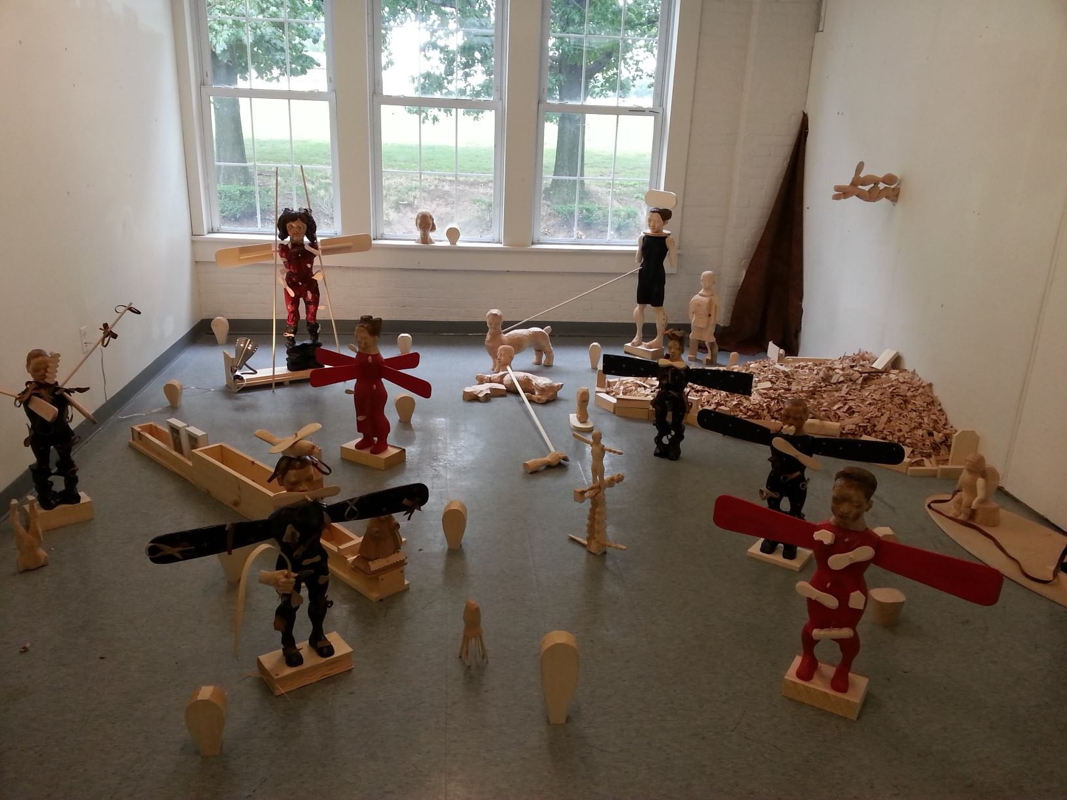
Installation view of "Possible Full Body Apparitions" at the Lower Manhattan Cultural Council Art Center, Bldg 110, Governor's Island. Open Studios July 13-14, 2013.
Yesterday I made two trips to Governor's Island to transport the last three pieces of the sculptures Ive stored in the apartment. Then I also took the last contents of tools in my studio (save for the chisels that I wanted to display - but may also pack up today). Every major activity that I have been doing lately is all about packing up, wrapping up. On my second trip out I met Jeremy on the street accompanying another grantee to the apartment. Serendipity has it, it was Yang Yeung, who I was supposed to meet in Hong Kong for the Glocal book project and yet for some reason I met her in New York as a fellow ACC grantee. Despite the expanse of the world cities are very well connected, I must say, for these meeting to happen. Anyway the sight of Jeremy with another grantee signaled for me the upcoming end of my New York journey. I am ready to leave, but somehow I cannot help but think how interesting and transformative this residency has been.
We went to a big dinner thing with the rest of the grantees last night at Congee Restaurant in Bowery. it turned out to be a very big meal, indeed. Chong was there, and I was surprised to discover that he had returned from Berlin and Beijing as his residency from ACC is over and he was there for the Lincoln Center festival. Of course Vollak, Taiyo and Takeshi were there, as was Jeff and Hiroyuki. Isa didn't make it, but I will go to her show tonight with the guys. Along with Tung Pang and Racquel, I believe all names mentioned we are the Spring-Summer batch of ACC peers. It is often quite nice to note how you are part of a group.
Today I am preparing to transport my very last pieces, from the Bliss exhibit, to the Studio at the Island. Ged Merino is helping me with the move. Tomorrow begins the two-day event that will serve as a preview of the Singapore show. Many of the artists in the studio like the work and were surprised at how much Ive made within the given period of the studio residency. Tomorrow begins the actual wrapping up, which culminates in Tuesday's pickup and packing up, and shipping. Then Ill just attend the Lincoln Center performance of Chinese acrobatics and beginning Wednesday, all I need is to clean up the studio, bid farewell to Governor's Island and start exploring the City once more, especially its museums.
I have three essential things left to do in NY: Visit MoMa, Revisit the Met and the Cloisters, and watch a Broadway Musical, perhaps Phantom for the experience. I would have placed going to the Empire State Building but I hate heights. I can walk across the Brooklyn Bridge as well, and if I have some time I can even go back on a day trip to DC, go to Dia Beacon and also Storm King, perhaps with the gang.
So there. I'm almost there.
Speaking of ghosts: my upcoming show at the Open Studio at Governor's Island is uncannily titled "Possible Full Body Apparitions". This is a phrase borrowed from ghost hunting jargon and is commonly used to refer to visual experience of paranormal phenomena, and is a fancy way of saying "I probably saw a ghost".
I chose this title as an apt phrase that encapsulates my experiences during the past five months here in New York. Americans in general do not readily believe in ghosts and often think of paranormal experiences as signs of "craziness".
"Ghost hunting" has indeed become my byword, my peg, for a hunt for the experience of something inexplicable and inchoate due to its obsolescence, strangeness and beyond scientific or pragmatic reckoning. It also refers to facts, objects and people rendered as "ghosts" for the simple fact of their irrelevance to contemporary issues and struggles. They appear, often as haunting, or as involuntary memory of the past, or the origins and roots of the present.
I found that in expressing to artists and curators here of my interest in lineage and tradition in artistic practice I often get the response that I am "out of touch". When asked what I wanted to see in New York I reply with "traditional native American art, pre-modern sculpture and non-Western cultural practices allied to image-making" and this elicited the same response when I say "I would like to do ghost-hunting". Both are "far out", and seen as curious, strange and even exotic.
The process of making the works for "Possible Full Body Apparitions" began as an exercise of remembering and unearthing the concept of Philippine anitos, or ancestor guardian spirits, who are for all intents and purposes ghosts of deceased relatives invoked for help in everyday matters. Rather than being supplanted by Christianity, this attachment to the anito has been appropriated by the Spanish colonizers by assigning familial epithets to its own santos (Mama Mary, Papa Jesus etc) and by use of graven images that can be touched (and where physical contact to the object is paramount gesture of faith). Having been trained in the practice of santo-making, I have attempted several times to "go far back" and reclaim the anitos from possible forgetting, and to render their presence as full body apparitions in wood and in leather.
Yet the intention of reaching out and reclaiming the past is an act often not associated with New York, a city of forward-looking modernity. At first I found myself in a curious position in the politics of locality and I often took on ghost-hunting as a literal and figurative activity to articulate this off-tangent confrontation to contemporary art practice in New York.
Eventually my sculptural work expanded to form a built environment of an installation where I try to represent the locations in Lower Manhattan and elsewhere, where I thought I found and felt, either residual memories and history, reminders of my own lineage as a Filipino, and other ghosts and hauntings, that are actively being replaced, and rebuilt or repurposed. Aware that such paranormal claims will be in all likelihood dismissed, I take the ironic position of portraying these presences anyway. Even as ghosts do not appear on demand, they are not also as likely to move away or disappear just because we do not want them there or here. Ghosts are entities that are generally unwanted, treated as an intruder here. By affiliating my work with them, I affirm the possibilities of my intrusion, my un-wantedness: but like ghosts, I will appear as I please no matter what.
And like all apparitions, considering my brief sojourn, me and my work will also vanish.
A colleague and former coworker at the National Commission for Culture and the Arts, Elmar Ingles, passed away last July 9 from what is described as "complications from diabetes". He was only 49. It was a sudden death, and one that shook me up for two reasons: he was a person that I have worked with and had projects with and because like him, I am diabetic. Those who are ill know that news like these can make you really feel how palpable mortality is. And like any artist I sense how life is truly short compared to the long process of perfecting one's craft. Moments like these make me feel a sense of urgency.
The last time I felt this urgency was when another colleague Sid Gomez Hildawa passed away around seven years ago. Our last conversation was about the need to prioritize a work path when one has many facets and skills. Sid was an architect, painter, poet and arts administrator among other things. Back then I confided in him that I felt I was losing it by various projects of curating, writing, teaching and arts management. I wanted to go back to full time art making. Sid and I were both diagnosed with different ailments that year. And when Sid died I took it as a sign that I have to choose what I really wanted to do. Thus I chose to make sculptures and the sense of urgency and the near-non-stop working calendar that I got myself into since 2008. There is nothing frivolous about my choice then as it is framed by a memento mori.
Now Elmar's demise makes this memento mori as real as it gets. Its not that I am afraid of death, no, not really. What I am wary of is not to be able to accomplish the works that I really wanted to make before I am cut down by the human condition of mortality. This is the compelling reason why I also am into paranormal research and ghost-hunting: I am curious how "unfinished business" lead to episodes of haunting. Because I do not want to have unfinished business in life, especially this particular incarnation and iteration. I want my consciousness to be free from attachments to possibilities when that hour arrives. I also want to leave without regrets and have my consciousness dissolve.
Speaking of ghosts: my upcoming show at the Open Studio at Governor's Island is uncannily titled "Possible Full Body Apparitions". This is a phrase borrowed from ghost hunting jargon and is commonly used to refer to visual experience of paranormal phenomena, and is a fancy way of saying "I probably saw a ghost".
Any choice can be made, and framed, at any of these instances: as a resolved conclusion, as an insightful answer to mystery, as a response to urges and appetites, as a determination of proper (re)action, and as a consequence of feeling, welling up in the soul. For any artist, any aesthetic choice can occur in these conditions, depending on his or her built-up responses to life.
Or at least that is what appeared to me today after ploughing through different exhibits from three different museums in the city.
Taiyo Kimura and Kong Vollak were my companions today as we set on a day of museum visits that included The Whitney Museum of American Art, The Bronx Museum for the Arts and the Jewish Museum. Taiyo suggested Whitney and The Jewish Museum because he wanted to see the works of Robert Irwin and Jack Goldstein, respectively. I suggested the Bronx because of Bronx Calling, the second AIM Biennial. And also because I have never ventured into The Bronx as a borough, not within the four months I have been in New York. We ended the evening in a Japanese drinking hole in St Marks Place, at the insistence of Vollak.
We were at the Whitney at opening time and surveyed all five floors top to bottom, for its permanent and temporary exhibits. So from the fifth floor we went through the survey of the American modernists - Hopper, O'Keefe, Nadelle, Davis - a journey that continued with an exhibition of Hopper's Drawings (on the 3rd) which I really, really liked. At the fourth level, Taiyo and I were stunned by the "Veil" by Robert Irwin which was a site-specific work for the Whitney and since its first exhibit in 1977 has not been shown in 35 years. Taiyo told me that Irwin, a Light and Space artist, was working within the same parameters as did James Turell whose show at the Guggenheim we also saw together two weeks ago. I understood why Taiyo wanted to see this piece, as I myself was astounded by its sheer simplicity and yet its magnificent presence. The use of a translucent screen to catch the light of a single window and allow it to skim gradually along its surface to a point (but presumably not end) of the far side of the wall is an astounding work of insightfulness and keen observation. If Irwin wanted to elicit wonder, he got that from me. But it was his framed statements about art "going beyond making" that made me shrug my shoulders. The work was enough, but his contrapuntal statements - perhaps needed to make discursive space for himself in the art politics of his period - were already superfluous.
It is quite odd actually for me to discern the same deliberateness of Irwin in the drawings of Hopper. Edward Hopper is an old favorite of mine and whose exhibition in Paris was ongoing at the Grand Palais while I was there last year. (I deferred going to the show because I knew I was going to see Hoppers in the US in a few months. This exhibition did not disappoint that choice.) The collection shows studies and various works on paper by Hopper, given context by the presentation of the very same paintings that were the results of these sketches. So while I finally found myself standing in front of "Night Hawks", I was privileged to see the drawing he made to make this. Imagine my surprise to see notes on his drawings, and annotations in his journals and logbooks that indicate precise placements of tone and shade at every part of the composition. Hopper saw to it that nothing was out of place and yet his painterly approach to his canvases remain fresh and without any sense of belaboring.
At the lower floors we saw the remounting of works by American artists from the 80's and 90's - from Kiki Smith, Keith Haring to Jean-Michel Basquiat - as a throwback to current issues of their day: AIDS, Reagan foreign policy, gay rights etc. While viewing the show it came to me that I have never been very acquainted with the history of American artists after World War 2. And this lack of information had contributed to my attitude towards post-modern American art in general. Quite curious how a simple survey, a simple viewing can change what I thought about these works. How did I ever even fall into this aesthetic bigotry in the first place? I mean, I love Kiki Smith. I found the works of Irwin, Goldstein and Turell very profound.
My education was incomplete, as my judgment of contemporary art and its antecedents in the 70's to the 90's is flawed from the lack of concrete information.
So it came as a bonus and a surprise for all of us when we discovered that a survey of West Coast art from the '70s was on show -for free- at the Bronx Museum. Taiyo was particularly amused as he did want to see a show like this. The exhibit was for me a way to confront and engage the West-Coast variety of conceptual art, language-based art, new media etc. Months before I would have reacted aggressively against seeing works like these. To my amazement, after weeks of concluding my personal experiment (see previous entries) the works actually appeared amusing. I loved the sense of irony, the courage to explore the boundaries of language and image and to audacious mockery of "traditions" and institutions. I was very drawn to the video of John Baldessari's performance where he was singing off-tune the postulations of Sol Lewitt: it was just too funny. I even found the book art of Ed Ruscha and Allan Kaprow arresting in their interest to map out immediate environs and gestures in their place. The show made me consider that aspect of observed phenomena of the "present" as a string of passing impressions and recordings.
Somehow, the AIM Biennial paled in comparison to this retrospective show. I could not help but think the contemporary works were just "following through" the explorations of the past four decades, in terms of form and modalities of practice. What is markedly different in the contemporary works is the regard for concrete situations - immediate history, revisionist politics, geo-cultural manifestations - that seem to be lost in the explorations of form, and in the reaches of semiotic art of the 70's.
The retrospective of Jack Goldstein's work at the Jewish Museum was a fitting end to the unfolding of the day. In fact I enjoyed all of his short films, which were quite properly projected using the same projection machines of his day. It was his late paintings that I found a bit off, although his use of flat planes of acrylic and the conscripting of assistants to do these for him (to remove himself as an author and assert his position as a director) were thought-provoking. But of course, someone like myself who takes pride in worksmanship and skill naturally would be estranged by this attitude. It did not prevent me, though, from giggling at his films, especially the one where a page of text is hurriedly read because it was rapidly being burned from top to bottom.
So as a rejoinder of my opening statement, I do say here that different artists call for different causes and different modalities are called in for different sets of concerns. There is no question of legitimacy here (which is a loaded question premised on lineage and institution), but rather of contextualization.
Looking forward to more.
I spent two consecutive days doing gallery and museum visits with my fellow ACC grantees. And for these two days I was all over New York City.
I had begun packing my stuff last Friday, as I mentally prepared myself for the final week of work at the LMCC Art Center and of the few weeks that remain for my ACC program. I was indeed attempting to lay down some frames of closure to some of the problems Ive found some form of resolution to and among them of course was the dichotomy that tore at the very core of my practice: the relevancy and legitimacy of my artistic practice. Yet even as I did not find a direct answer, I was able to examine the parameters of the anxiety surrounding the problem and found out, inadvertently and by accident, that the question was, even though articulated in reasoned arguments, was essentially an emotional one. The shadow that I have been trying so hard to pin down - almost through paranormal means but almost always through my sculptural work - turned out to be very underdeveloped Feeling/Sensation, if I reference the Jungian Myers-Briggs test. Having ignored processing feelings and sensations for the majority of my life due to their associations of pain, these aspects of my self have accrued into an alterego, a shadow; curiously these found an outlet in my artistic working mannerisms and approaches. And overflowed, unfiltered, into the discourse that surrounded my awareness with a tension, akin to aggression versus concept-driven art. I was not really looking to forge a new theoretical approach in framing my work (that is easy), but I was having difficulties expressing my desire to make people accept them and thus establish their relevance.
The desire to be accepted was being channelled into the desire to be relevant. The first is a personal matter that needed articulation and the second is a discursive and contentious stake that can only be addressed in the engagement of the work with the community and space it seeks to gain value. And that is knowing how to locate oneself in the politics of space.
Interestingly enough the loosening of the entanglements of my feelings and my aesthetic propositions found their stage when I decided to join Jeff Leung and others to see an exhibit opening at Interstate Projects in Bushwick, Brooklyn. In a chance meeting, Jeff introduced me to Madeleine and Clinton, two artists working in Brooklyn and living within a community where artists have their studios, lofts and workspaces in proximity to each other. Madie is a HongKong-born New Yorker, and unaware I was at that moment, I already her at Tung Pang's Dont Miss Me Party in John Street. (We discovered that later over dinner). Clinton is an American abstract painter, who according to Jeff, used to do projects under Sol Lewitt, although this is still vague at the moment for me. But in the course of our conversations, especially over the subject of strange food, and into the paranormal, we discovered an uncanny common ground: we both work from Jungian theories. (Which Jeff couldn't also believe since he also began to read Jung coming to New York a month ago). And what was more surprising was we were both working on the concept of the Shadow from different artistic persuasions and disciplines. While I approached the subject by means of hand-made objects, traditional crafts and figurative iconography, Clint was able to paint using gestures and layers, and by channeling the energy of his own unacknowledged darkness. But we were both using art as means to a goal: integration and balance of the psyche.
After visiting Fuchs gallery in the Bushwick studios and having a "non-Asian" dinner at Madie's insistence at an Italian restaurant near Graham St, Clint offered his stock of beer to us at his place. Over at his apartment I was able to see what the living quarters of local artist would look like. (And I understood what Jeff said that the environs and models of artists' spaces in Brooklyn reflected those of the same with Asian artists living in the metro.) After sharing ghost stores and encounters with apparitions, Clint pointed out that these images - although fecund with the dark mass of the unknown shadow - are projections. And that I adjoined, was the starting point of my own work: I was trying to give shape and body to these projections so I can handle them concretely as a form of Shadow Work. Clint on the other hand, does a form of shadow work by calling out to the spirit of his Anima and by channeling the energy of Her presence, he paints, sans images. We spoke on the Myers-Briggs typology and noted the polarity of our types.
If that wasn't strange coincidence enough, I have to say that the one work that drew me in the exhibition in Interstate was a supposed project to create a "Psychoanalyst Park" attraction on Coney Island. Though that project was taking off from Freudian theories, I cannot but help thinking that unconsciously I was being guided to consider the Mind, not its constructs, as the subject that had significance at the moment.
Could it be possible, that what appeared to me as a contention of aesthetics was actually the dynamics of psychic compensations: the dynamics of projection, acknowledgment and integration to forge a balance? To discover another person like Clint who was working the same problem as I am but with different perceptual sets and skills - made me reconsider this. Brenda Fajardo once told me a decade ago that most Filipino artists tend to be of the Extrovert-Intuitive-Feeling-Sensation type. Perhaps, Roberto Chabet (An Introverted-Thinking-Perceptual-Judging type) was indeed bound to happen as a matter of balance. (As Clint said that Conceptual Art, Minimalism and Color Field were bound to happen in the trajectory of art practice from Duchamp.) I mean, I begin to be hopeful, that art and its institutions and practices and works operate from within promptings of the various dimensions of the Psyche.
It looks like the storm is over in my soul.
I took the Myers-Briggs personality test and this came out: VERY ACCURATE Your personality type has been calculated as INTP.
The description of this personality type from Wikipedia is: INTPs are quiet, thoughtful, analytical individuals who tend to spend long periods of time on their own, working through problems and forming solutions. They are curious about systems and how things work. Consequently, they are frequently found in careers such as science, philosophy, law, and architecture. INTPs tend to be less at ease in social situations or in the "caring professions", although they enjoy the company of those who share their interests. They prize autonomy in themselves and others. They generally balk at attempts by others to convince them to change. They also tend to be impatient with the bureaucracy, rigid hierarchies, and the politics prevalent in many professions. INTPs have little regard for titles and badges, which they often consider to be unjustified. INTPs usually come to distrust authority as hindering the uptake of novel ideas and the search for knowledge. INTPs accept ideas based on merit, rather than tradition or authority. They have little patience for social customs that seem illogical or that serve as obstacles for pursuing ideas and knowledge. This may place them at odds with people who have an SJ preference, since SJs tend to defer to authority, tradition, and what the rest of the group is doing. INTPs prefer to work informally with others as equals.
INTPs organize their understanding of any topic by articulating principles, and they are especially drawn to theoretical constructs. Having articulated these principles for themselves, they can demonstrate remarkable skill in explaining complex ideas to others in simple terms, especially in writing. On the other hand, their ability to grasp complexity may also lead them to provide overly detailed explanations of simple ideas, and listeners may judge that the INTP makes things more difficult than they need to be. To the INTPs' mind, they are presenting all the relevant information or trying to crystallize the concept as clearly as possible.
Given their independent nature, INTPs may prefer working alone to leading or following in a group. During interactions with others, if INTPs are focused on gathering information, they may seem oblivious, aloof, or even rebellious—when in fact they are concentrating on listening and understanding. However, INTPs' extraverted intuition often gives them a quick wit, especially with language. They may defuse tension through comical observations and references. They can be charming, even in their quiet reserve, and are sometimes surprised by the high esteem in which their friends and colleagues hold them.
INTPs are driven to fully understand a discussion from all relevant angles. Their impatience with seemingly indefensible ideas can make them particularly devastating at debate. When INTPs feel insulted, they may respond with sudden, cutting criticism. After such an incident, INTPs are likely to be as bewildered as the recipient. They have broken the rules of debate and exposed their raw emotions. To INTPs, this is the crux of the problem: improperly handled emotions, INTPs believe, can only harm. While INTPs experience emotions as an important part of their internal lives, and sometimes share their emotions with others, INTPs nevertheless believe that emotions must not play a role in logical discussions, or be expressed in a way that would put themselves at disadvantage.
According to Keirsey, based on behavioral characteristics, notable Architects might include Albert Einstein, Charles Darwin, and Thomas Jefferson.
|
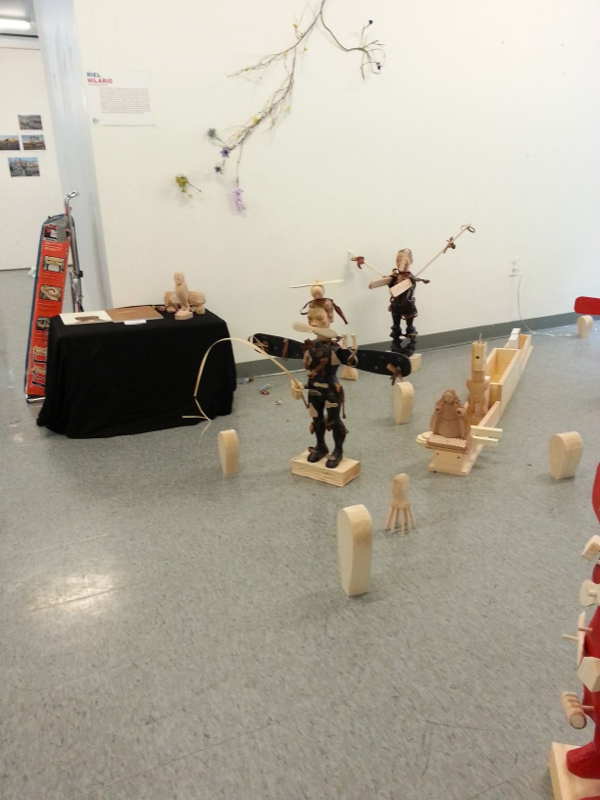

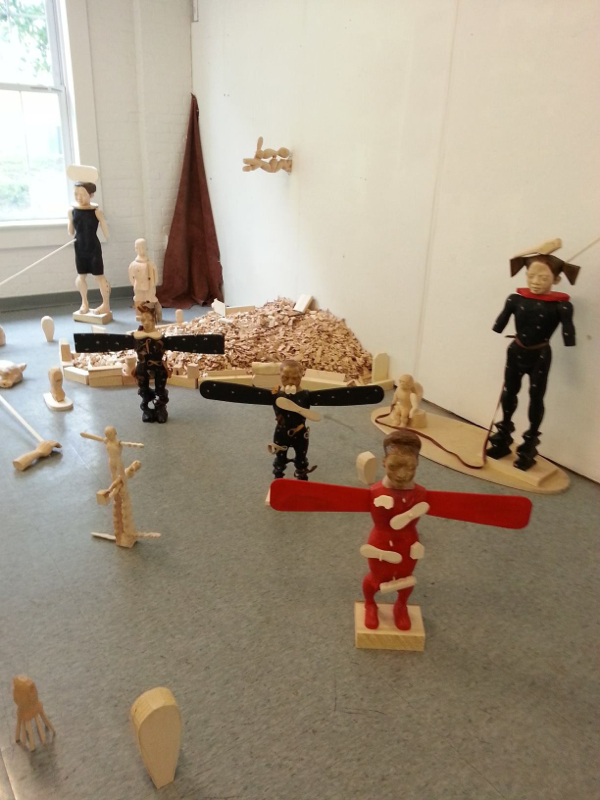
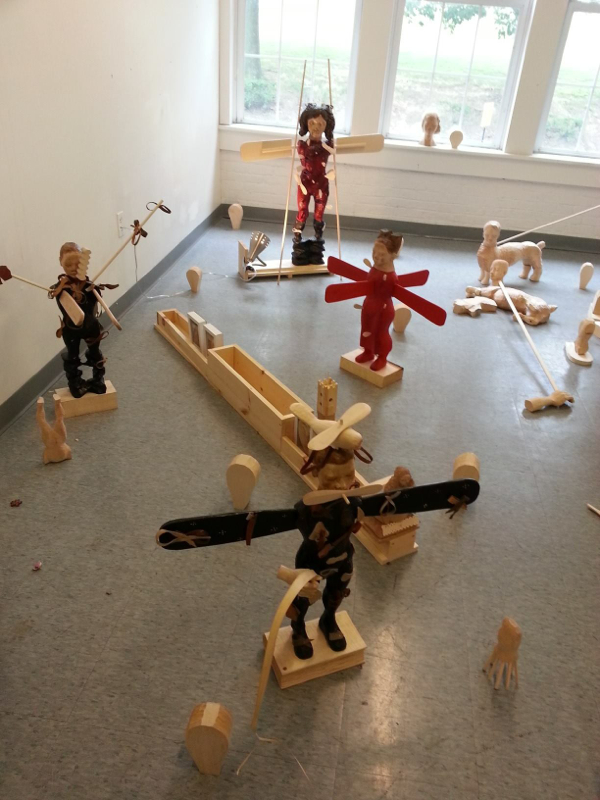
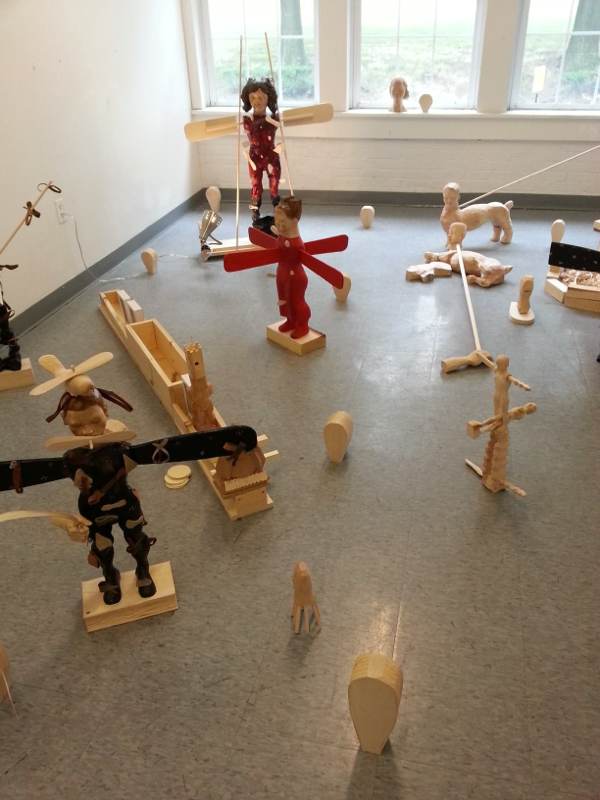
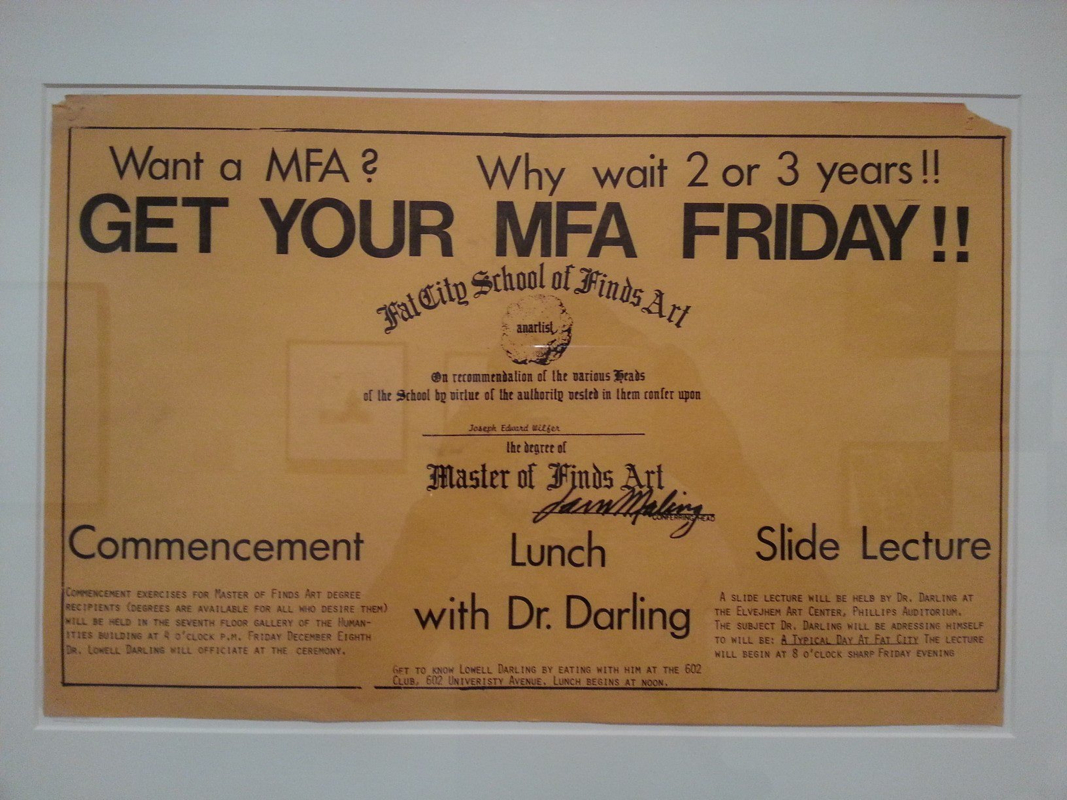
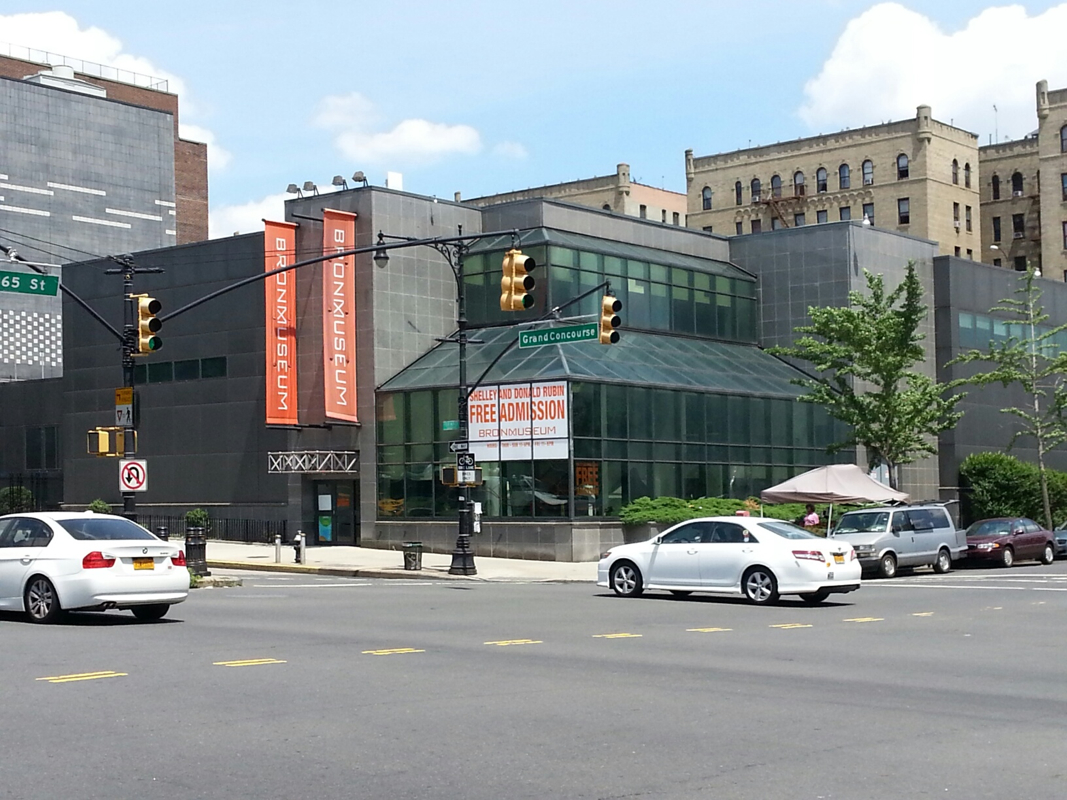
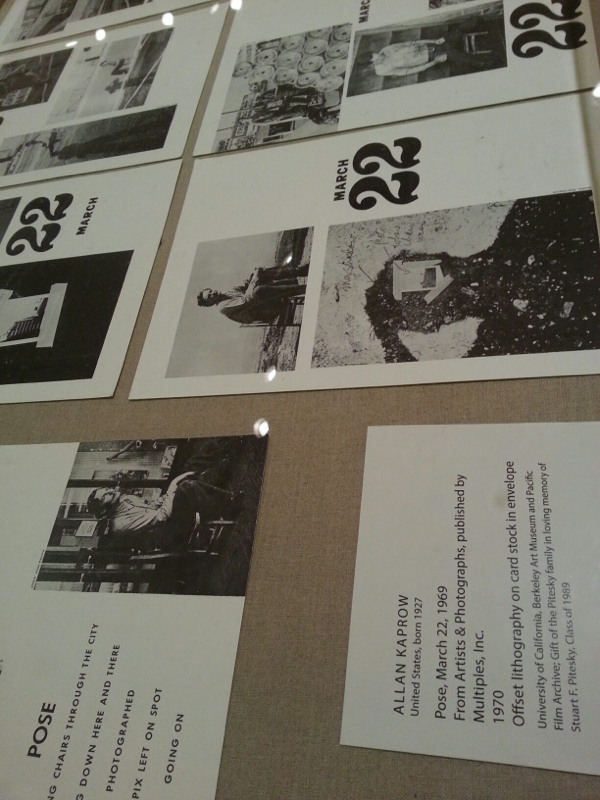
 RSS Feed
RSS Feed